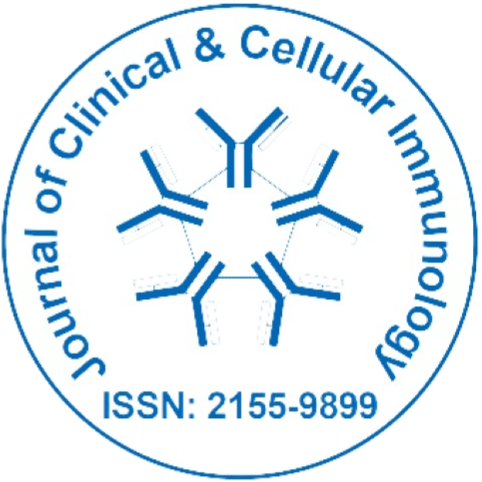
Journal of Clinical and Cellular Immunology
Open Access
ISSN: 2155-9899

ISSN: 2155-9899
Commentary - (2025)Volume 16, Issue 2
Immunology is rapidly evolving beyond the characterization of isolated pathways and cell types to a more integrated understanding of the immune system as a complex, dynamic network. This shift is fueled by advances in technology and computational biology that allow the simultaneous analysis of multiple immune components across time and tissue contexts. The emerging discipline of integrative immunology seeks to bridge fundamental mechanistic insights with holistic systems-level perspectives, enabling more precise and effective therapeutic innovations for a wide spectrum of diseases.
From reductionism to integration: Mapping immune complexity
For much of its history, immunology has relied on reductionist approaches dissecting individual receptors, signaling molecules, and cellular functions in isolation. These efforts produced transformative discoveries the identification of T and B lymphocytes, antigen presentation mechanisms, cytokine networks, and immune checkpoints. While invaluable, this approach cannot fully explain the multifaceted and context-dependent nature of immune responses.
Integrative immunology embraces complexity by combining high-throughput experimental techniques with computational modeling to capture the diverse cellular states, spatial organization, and temporal dynamics of immune systems. Technologies such as single-cell RNA sequencing, mass cytometry, and spatial transcriptomics enable the characterization of thousands of immune and non-immune cells simultaneously, revealing heterogeneity within classical cell populations and uncovering rare or previously unknown cell types.
For example, single-cell analyses in cancer patients have revealed multiple states of exhausted T cells with distinct functional capacities and metabolic profiles, challenging the notion of exhaustion as a uniform phenotype. Similarly, spatial mapping of tumor and inflamed tissues uncovers the precise niches where immune suppression or activation occurs, informing targeted interventions.
Moreover, integrative studies highlight the crucial roles of non-immune cells including stromal fibroblasts, endothelial cells, and epithelial barriers in modulating immune responses. These cells interact bidirectionally with immune populations, influencing inflammation, tissue repair, and fibrosis. By considering these complex networks, integrative immunology provides a more accurate representation of disease biology.
Translating mechanistic insights into therapeutic breakthroughs
Understanding immune complexity is not merely an academic exercise it is the foundation for rational therapeutic innovation. Integrative immunology fuels the design of precision medicines that tailor immune modulation to individual patients and disease contexts.
Precision immunotherapies: Molecular profiling guides patient stratification and biomarker development, enabling therapies to target relevant immune checkpoints, cytokines, or cellular populations. In oncology, immune checkpoint inhibitors (e.g., anti-PD-1/PD-L1 therapies) have revolutionized treatment, but only subsets of patients respond. Integrative analyses of tumor microenvironments now inform combinatorial strategies to overcome resistance by targeting suppressive myeloid cells or metabolic checkpoints.
Targeting non-canonical immune pathways: Beyond classical pathways, non-canonical mechanisms such as alternative inflammasomes, regulatory innate lymphoid cells, and immune functions of stromal cells represent novel therapeutic targets. Modulating these pathways holds promise for conditions where traditional immunosuppression fails, such as chronic inflammatory diseases, fibrotic disorders, and certain cancers.
Engineered immune cells: Advances in gene editing and synthetic biology allow the generation of customized cellular therapies. Chimeric Antigen Receptor (CAR) T cells targeting hematologic malignancies exemplify this progress. Expanding these approaches to solid tumors, autoimmune diseases, and infectious diseases relies on integrative knowledge of immune cell states, trafficking, and tissue microenvironments.
Systems pharmacology and combinatorial approaches: Integrative models predict synergistic effects of drug combinations, enabling rational design of therapies that modulate multiple immune nodes simultaneously. For autoimmune diseases, such combinations might balance suppression of pathogenic immune responses with preservation of protective immunity.
Importantly, the iterative feedback loop between laboratory discovery, computational modeling, and clinical testing accelerates the translation of insights into patient benefit. This dynamic process is a hallmark of integrative immunology.
Despite its promise, integrative immunology faces significant challenges. The sheer volume and complexity of data require sophisticated bioinformatics tools and standardization to ensure reproducibility and interpretability. Additionally, immune responses vary widely between individuals due to genetic, environmental, and microbiome factors, demanding large and diverse datasets to capture this heterogeneity.
Temporal dynamics add another layer of complexity. Immune responses evolve over hours, days, or years, and the timing of therapeutic intervention can profoundly influence outcomes. Longitudinal studies and real-time monitoring technologies are critical for capturing these kinetics.
Ethical and regulatory considerations also arise as therapies become increasingly personalized and complex, requiring robust frameworks to evaluate safety and efficacy.
This integrative approach not only enhances our biological understanding but also drives the development of innovative therapies from precision immunomodulators and engineered cellular products to combination regimens guided by computational models. As the field advances, collaborative efforts spanning immunology, computational biology, clinical medicine, and bioengineering will be crucial to translate this knowledge into tangible improvements in patient care.
Citation: Anastasia J (2025). Integrative Immunology: Linking Basic Mechanisms to Therapeutic Innovation. J Clin Cell Immunol. 16:760
Received: 29-May-2025, Manuscript No. JCCI-25-38842 ; Editor assigned: 02-Jun-2025, Pre QC No. JCCI-25-38842 (PQ); Reviewed: 16-Jun-2025, QC No. JCCI-25-38842 ; Revised: 23-Jun-2025, Manuscript No. JCCI-25-38842 (R); Published: 30-Jun-2025 , DOI: 10.35248/2155-9899.25.16.760
Copyright: © 2025 Anastasia J. This is an open-access article distributed under the terms of the Creative Commons Attribution License, which permits unrestricted use, distribution, and reproduction in any medium, provided the original author and source are credited.